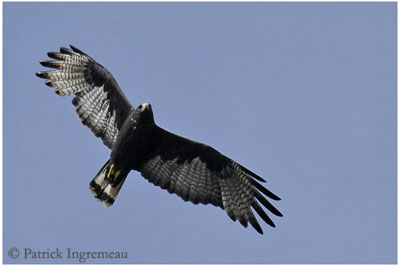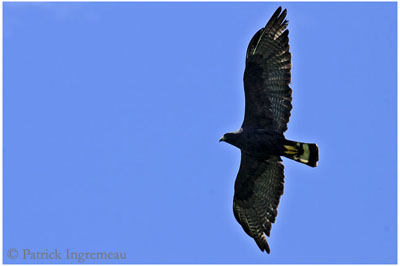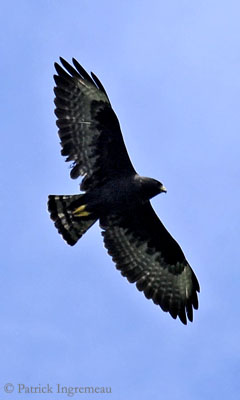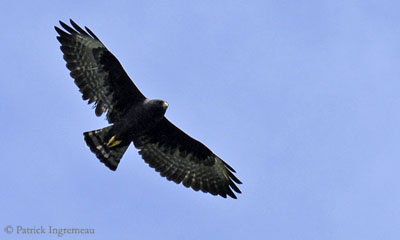
Zone-tailed Hawk
Buteo albonotatus
Accipitriforme Order – Accipitridae Family
BIOMETRICS:
Length: 45-56 cm
Wingspan: 119-140 cm
Weight: M : 610-660g – F : 845-940g
DESCRIPTION:
Zone-tailed Hawk is medium-sized raptor, often confused with Turkey Vulture.
Adult has slaty black plumage with faint brownish tinge on upperparts. Tail shows two or three pale bands. They appear white from below, but they are grey from above. When in flight, underwings appear two-toned, with pale grey flight feathers, finely barred with dusky bands, and broad dark trailing edge. Broad wings are rounded.
Head is slaty black with pale grey lores. Eyes are dark brown to reddish-brown. Hooked bill is blackish with yellow cere. Tarsi and feet are yellow.
DIET:
Zone-tailed Hawk feeds on vertebrates such as passerines, mammals as ground squirrels, amphibians and reptiles (lizards).
PROTECTION / THREATS / STATUS:
Zone-tailed Hawk may be vulnerable to pesticides in winter areas in Mexico and South and Central America. Species is also threatened by habitat loss in Arizona, with degradation for agricultural and human developments. It is vulnerable to disturbance at nest.
Species is not considered as Endangered or Threatened, except in Texas because of loss of nesting habitat. Populations need constant monitoring.
Fr: Buse à queue barrée
All : Mohrenbussard
Esp : Busardo Aura
Ital : Poiana codafasciata
Nd : Bandstaartbuizerd
Sd : Bandstjärtad vråk
Photos de Patrick Ingremeau
TAMANDUA
Texte de Nicole Bouglouan
Sources:
HANDBOOK OF THE BIRDS OF THE WORLD Vol 2 by Josep del Hoyo-Andrew Elliot-Jordi Sargatal - Lynx Edicions - ISBN: 8487334156
A GUIDE TO THE BIRDS OF MEXICO AND NORTHERN CENTRAL AMERICA by Steve N. G. Howell, Sophie Webb - Oxford University Press - ISBN: 0198540124
A GUIDE TO THE BIRDS OF COLOMBIA by Steven L. Hilty and William L. Brown - Princeton University Press – ISBN 069108372X
What Bird-The ultimate Bird Guide (Mitchell Waite)
Wikipedia (Wikipedia, The Free Encyclopedia)

Both sexes are similar in plumage, but female is larger than male.
Juvenile has greyish tail and lacks broad pale bars. Underwings and undertail are similar and two-toned. And we can see white flecking on breast.
VOICE: SOUNDS BY XENO-CANTO
Zone-tailed Hawk utters various calls, according to the situations.
Alarm call is a harsh “kreeeee”, if predator approaches near nest. When adults are soaring or hunting, they utter a harsh “kreeeee-arrr”. Male can also utter this call during courtship and before copulation. When female is incubating, she utters a rapid “E-gip” when male approaches for giving her a prey. Shrill, rapid call “kip-kip-kip-kip” may be given by both adults in response to each other during nesting stage.
The most common call is “kreeeee”, given by adults and young when disturbed. Just fledged young beg for food with plaintive, high-pitched “kreeep”. When young receive prey, they utter a shrill “weee-uk”.
HABITAT:
Zone-tailed Hawk lives mainly in deep, rough and rocky wooded canyons, tree-lined rivers near mountains, valleys… it hunts in open areas, in desert grasslands or open forests.

RANGE:
Zone-tailed Hawk is found from south-western United States to Central and South America. Populations breeding in US and northern Mexico are migratory. Birds can perform altitudinal movements in winter in South Mexico, moving to lower elevation.
BEHAVIOUR:
Zone-tailed Hawk has varied hunting strategies. It often flies 40 to 150 metres above the ground, with wings in characteristic V, named dihedral position, and it stops on prey, bending wings at carpal joint.
It also can hunt by circling at about 15 to 60 metres. When prey is located, it drops behind cover for turning, and then, it approaches within 0, 5 to 2 metres, always behind cover, before striking it.
It also hunts from perch in riparian trees in the early morning.

Zone-tailed Hawk performs flight displays over potential breeding habitat. These displays include circling, screams, talon-grappling, and tumbling towards ground, called “whirling” (by Brown and Amadon – 1968). These displays seem to continue during breeding season. Before to copulate, male sometimes soars in circle above female, while screaming. Female waits for it perched on exposed open tree branch, screaming too. After copulation, female tucks head into fluffed breast, motionless for several minutes. Male performs other displays after copulation, including high, upwards-spiralling and soaring flights above the area, and uttering high-pitched calls. They seem to be monogamous and solitary nesters.
Zone-tailed Hawk can harass other birds of prey entering breeding territory. But it is often seen soaring with Turkey Vultures. It chases other raptors away from the nest-site, flying directly over or at intruder, while screaming loudly. If intruder is only a few metres from the nest, male attacks immediately, with legs and talons extended and wings raised in V-shape.
Pair is aggressively territorial when nestlings are present.
FLIGHT:
Zone-tailed Hawk performs soaring dihedral flight with few slow wing beats. It also performs dihedral flight with rapid wing beats alternated with folded wings in rapid flight, and associated with hunting.

REPRODUCTION:
Zone-tailed Hawk builds its nest in deciduous or coniferous tall tree. This nest may be reused from year to year. These raptors nest in high mountain mixed forests, scrubby lowlands riparian cliffs, and on remote north-facing slopes among stands of tall Ponderosa pines. North-facing slopes provide cooler temperatures during warm summer days.
Nest is built by both adults. Male often brings materials. Nest is placed in main fork at or near top of tall tree. It is made with pine and oak sticks of about 25 to 40 cm in length. Interior is lined with fresh mosses, bark, leaves and pine needles. It is a bulky nest.
Female lays 1 to 3 bluish white or dead white eggs, sometimes finely granulated. Incubation lasts about 35 days, mainly by female. Male delivers prey and female leaves the nest for feeding, while male perches on nest, looking at eggs and then settling onto eggs. Female may be fed 2 or 3 times per day by male.
Chicks are semi-altricial, covered with grey down. Female feeds young with prey delivered by male at nest. Young are directly fed during the first 40 days. Then, they are able to eat by themselves. They climb and hop from branch to nest at about 35 to 40 days of age, and leave the nest at 41 to 51 days after hatching. They are fully feathered and able to fly. Often, younger nestling is too weak for taking food, and it dies very soon.
Fledglings remain near the nest-site for one week, returning to nest for food. They are still fed in nest vicinity for several weeks.
